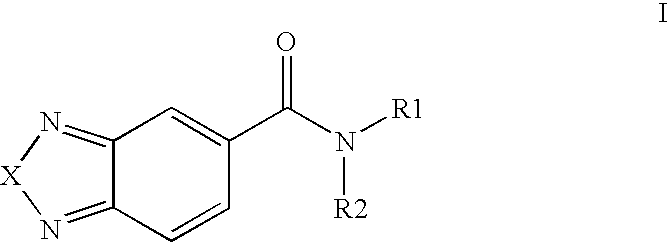Di-substituted amides for enhancing glutamatergic synaptic responses
a glutamatergic synaptic and di-substituted technology, applied in the field of compounds, can solve problems such as schizophrenia or schizophreniform behavior, and achieve the effects of increasing the amplitude of the field, stabilizing the baseline of evoked responses, and increasing the field amplitud
- Summary
- Abstract
- Description
- Claims
- Application Information
AI Technical Summary
Benefits of technology
Problems solved by technology
Method used
Image
Examples
example 1
N-Cycloheptyl-N-methyl-[2,1,3]-benzoxadiazole-5-carboxamide
[0231]
[0232]To a solution of cycloheptanone (1.12 g, 10 mmol) in 40 ml of ethanol was added a methylamine (2.5 ml of a 33% solution in ethanol) and 220 mg of Pd on C (10%) were added, and the mixture hydrogenated at 50 psi over night. The solids were filtered off and the mixture concentrated under vacuum to give a pale yellow oil. This material and 1.2 ml of triethylamine were dissolved in 10 ml of dichloromethane and a solution of [2,1,3]-benzoxadiazole-5-carbonylchloride (730 mg, 4 mmol) was added slowly. After stirring the mixture for 2 hours, the organic phase was washed with 1N HCl and conc. NaHCO3 solution, dried over magnesium sulfate, and then concentrated under vacuum to give a white solid, after trituration with ether (405 mg, 37%). Mp: 80-81° C., 1H NMR (300 MHz, CDCl3, rotamers) δ 7.93 (m, 1H); 7.80 (s, 1H); 7.43-7.37 (m, 1H); 4.75-4.60 and 3.70-3.55 (m+m, 1H); 3.01 and 2.87 (s+s, 3H); 2.00-1.20 ppm (m, 12H).
example 2
N-(4,4-Dimethylcyclohexyl-N-methyl-[2,1,3]-benzoxadiazole-5-carboxamide
[0233]
[0234]Methylamine, generated by heating a mixture of methylamine hydrochloride (10 g) and is sodium hydroxide pellets (18 g), was condensed (dry ice trap) into a solution of 4,4-dimethylcyclohexanone (1.0 g, 7.9 mmol) in 40 ml of methanol and 20 ml of THF. 10% Pd on C (400 mg) was added and the mix was hydrogenated at room temperature over night. The solids were filtered off, and the mixture concentrated under vacuum. This material and triethylamine (2 ml) were dissolved in chloroform (50 ml) and a solution of [2,1,3]-benzoxadiazole-5-carbonylchloride (900 mg, 4.9 mmol), in chloroform (40 ml), was added slowly at room temperature. After stirring the mixture for 1 hour, the organic phase was washed with 1N HCl and conc. NaHCO3 solution, dried over sodium sulfate, and concentrated under vacuum to yield an oil, which was purified using silica gel chromatography eluting with chloroform / ethyl acetate / hexane (10:...
example 3
N-Methyl-N-spiro[2.5]oct-6-yl-[2,1,3]-benzoxadiazole-5-carboxamide
[0235]
[0236]A solution of benzyl spiro[2.5]oct-6-yl carbamate (1.1 g, 3.85 mmol) in THF (40 ml) was slowly added to LiAlH4 (1.0 g) in THF (40 ml), at room temperature, and the mixture stirred for 2 hours. The mixture was then cooled with ice / water and hexane (35 ml) was added, followed by careful addition of a solution of sodium hydroxide (1 g) in water (4 ml). Celite was added, the mixture was filtered and the filtrate concentrated under vacuum. A solution of triethylamine (2 ml) in chloroform (60 ml) was added to the residue followed by a solution of [2,1,3]-benzoxadiazole-5-carbonylchloride (704 mg, 6 mmol), in chloroform (10 ml). After stirring the mixture for 1 hour, the organic phase was washed with 1N sulfuric acid and conc. NaHCO3 solution, the aqueous phases were re-extracted with chloroform (100 ml), and the combined organic phases were dried over magnesium sulfate, concentrated under vacuum and chromatograp...
PUM
| Property | Measurement | Unit |
|---|---|---|
| temperature | aaaaa | aaaaa |
| temperature | aaaaa | aaaaa |
| temperature | aaaaa | aaaaa |
Abstract
Description
Claims
Application Information
 Login to View More
Login to View More - R&D
- Intellectual Property
- Life Sciences
- Materials
- Tech Scout
- Unparalleled Data Quality
- Higher Quality Content
- 60% Fewer Hallucinations
Browse by: Latest US Patents, China's latest patents, Technical Efficacy Thesaurus, Application Domain, Technology Topic, Popular Technical Reports.
© 2025 PatSnap. All rights reserved.Legal|Privacy policy|Modern Slavery Act Transparency Statement|Sitemap|About US| Contact US: help@patsnap.com



